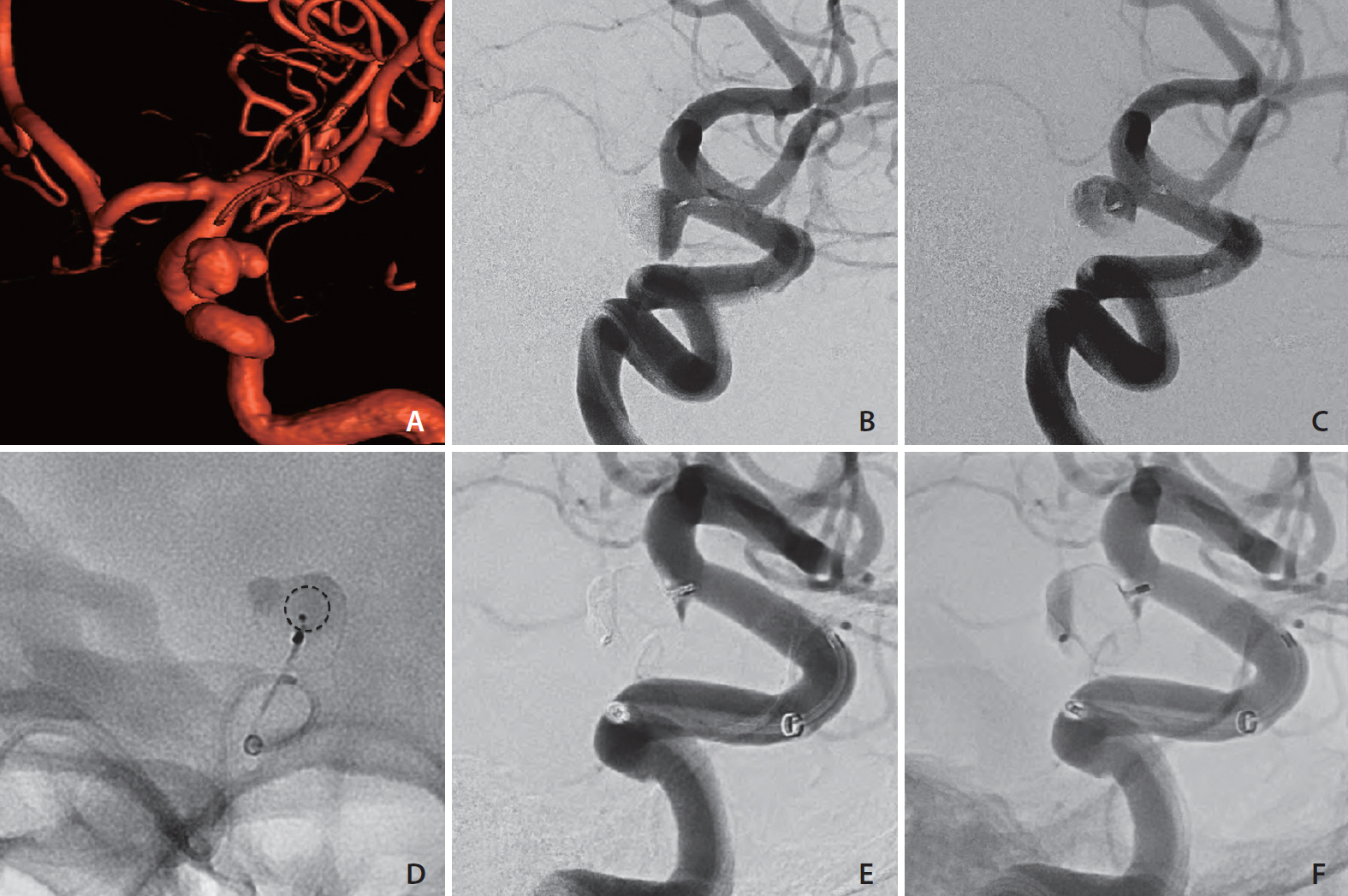Neurointervention.
2021 Nov;16(3):275-279. 10.5469/neuroint.2021.00318.
Adjustment of Malpositioned Woven EndoBridge Device Using Gooseneck Snare: Complication Management Technique
- Affiliations
-
- 1Division of Interventional Neuroradiology, Goodman Campbell Brain and Spine, Ascension St. Vincent Medical Center, Indianapolis, IN, USA
- 2Department of Endovascular Neurosurgery and Neurocritical Care, Westchester Medical Center, Valhalla, NY, USA
- KMID: 2522042
- DOI: http://doi.org/10.5469/neuroint.2021.00318
Abstract
- The Woven EndoBridge (WEB) is an intrasaccular flow-disrupting device for the treatment of wide-necked saccular cerebral aneurysms. As with any neuroendovascular device, complications in the form of malpositioning and migration must be managed quickly and safely. Few studies have reported complication management techniques in instances of dislocated or migrated WEB devices. We retrospectively describe a case of a malpositioned WEB device that was successfully adjusted with the use of a gooseneck snare. Multiple other intra-procedural bailout strategies for management of WEB malposition and migration were considered, and are herein discussed. Operators should be aware of the causes of WEB malposition and a variety of bailout strategies.
Keyword
Figure
Cited by 1 articles
-
Woven EndoBridge Device Migration and Microsnare Retrieval Strategy: Single Institutional Case Reports with Technical Video Demonstration
Brandon A. Santhumayor, Timothy G. White, Cassidy Werner, Kevin Shah, Henry H. Woo
Neurointervention. 2023;18(2):129-134. doi: 10.5469/neuroint.2023.00136.
Reference
-
1. Bechan RS, Sprengers ME, Majoie CB, Peluso JP, Sluzewski M, van Rooij WJ. Stent-assisted coil embolization of intracranial aneurysms: complications in acutely ruptured versus unruptured aneurysms. AJNR Am J Neuroradiol. 2016; 37:502–507.
Article2. Fiorella D, Molyneux A, Coon A, Szikora I, Saatci I, Baltacioglu F, WEB-IT Study Investigators, et al. Demographic, procedural and 30-day safety results from the WEB Intra-saccular Therapy Study (WEB-IT). J Neurointerv Surg. 2017; 9:1191–1196.
Article3. Pierot L, Arthur A, Spelle L, Fiorella D. Current evaluation of the safety and efficacy of aneurysm treatment with the WEB device. AJNR Am J Neuroradiol. 2016; 37:586–587.
Article4. Pierot L, Moret J, Turjman F, Herbreteau D, Raoult H, Barreau X, et al. WEB treatment of intracranial aneurysms: clinical and anatomic results in the French observatory. AJNR Am J Neuroradiol. 2016; 37:655–659.
Article5. Pierot L, Spelle L, Molyneux A, Byrne J; WEBCAST and French Observatory Investigators. Clinical and anatomical follow-up in patients with aneurysms treated with the WEB device: 1-year follow-up report in the cumulated population of 2 prospective, multicenter series (WEBCAST and French observatory). Neurosurgery. 2016; 78:133–141.6. Crinnion W, Bhogal P, Makalanda HLD, Wong K, Arthur A, Cognard C, et al. The Woven Endobridge as a treatment for acutely ruptured aneurysms: a review of the literature. [published online ahead of print Jan 28, 2021]. Interv Neuroradiol. 2021.
Article7. Goertz L, Liebig T, Siebert E, Herzberg M, Borggrefe J, Lichtenstein T, et al. Extending the indication of Woven EndoBridge (WEB) embolization to internal carotid artery aneurysms: a multicenter safety and feasibility study. World Neurosurg. 2019; 126:e965–e974.
Article8. Aguiar G, Caroff J, Mihalea C, Cortese J, Girot JB, Elawady A, et al. WEB device for treatment of posterior communicating artery aneurysms. [published online ahead of print May 11, 2021]. J Neurointerv Surg. 2021.
Article9. Cortez GM, Akture E, Monteiro A, Arthur AS, Peterson J, Dornbos D, et al. Woven EndoBridge device for ruptured aneurysms: perioperative results of a US multicenter experience. [published online ahead of print Jan 22, 2021]. J Neurointerv Surg. 2021.
Article10. Kabbasch C, Goertz L, Siebert E, Herzberg M, Borggrefe J, Krischek B, et al. WEB embolization versus stent-assisted coiling: comparison of complication rates and angiographic outcomes. J Neurointerv Surg. 2019; 11:812–816.
Article11. Chapot R, Mosimann PJ, Darsaut TE, Raymond J. Retreatments must be included in the evaluation of device performance. J Neurointerv Surg. 2021; 13:e5.
Article12. Pierot L, Szikora I, Barreau X, Holtmannspoetter M, Spelle L, Herbreteau D, et al. Aneurysm treatment with WEB in the cumulative population of two prospective, multicenter series: 3-year follow-up. J Neurointerv Surg. 2021; 13:363–368.
Article13. König I, Weber A, Weber W, Fischer S. Dislocation of a WEB device into the middle cerebral artery: removal with the alligator retrieval device. Clin Neuroradiol. 2019; 29:361–364.14. John S, Navarro R, Hussain SI, Zahra K, Elhammady MS. Rescue maneuver for dislocated Woven EndoBridge device in middle cerebral artery. World Neurosurg. 2019; 130:467–469.
Article15. Simgen A, Kettner M, Dietrich P, Tomori T, Mühl-Benninghaus R, Bhogal P, et al. Different rescue approaches of migrated Woven Endobridge (WEB) devices: an animal study. Clin Neuroradiol. 2021; 31:431–438.
Article16. Simgen A, Yilmaz U, Dietrich P, Tomori T, Mühl-Benninghaus R, Laschke MW, et al. Rescue of migrated Woven Endobridge devices using a stent-retriever-technique in a porcine model. Interv Neuroradiol. 2020; 26:772–778.
Article
- Full Text Links
- Actions
-
Cited
- CITED
-
- Close
- Share
- Similar articles
-
- Woven EndoBridge Device Migration and Microsnare Retrieval Strategy: Single Institutional Case Reports with Technical Video Demonstration
- Woven Endobridge (WEB) augmented by Y-stent in a shallow basilar tip aneurysm
- Ten Years of Clinical Evaluation of the Woven EndoBridge: A Safe and Effective Treatment for Wide-Neck Bifurcation Aneurysms
- Retrieval of Displaced Woven EndoBridge Intrasaccular Flow Disruptor Using Solitaire Platinum Revascularization Device
- Application of the Woven EndoBridge Device in the Treatment of Multiple Aneurysms of the Distal Posterior Cerebral Artery: A Case Report


